 | ÐлекÑÑоннÑй компоненÑ: IRL530N | СкаÑаÑÑ:  PDF PDF  ZIP ZIP |
Äîêóìåíòàöèÿ è îïèñàíèÿ www.docs.chipfind.ru
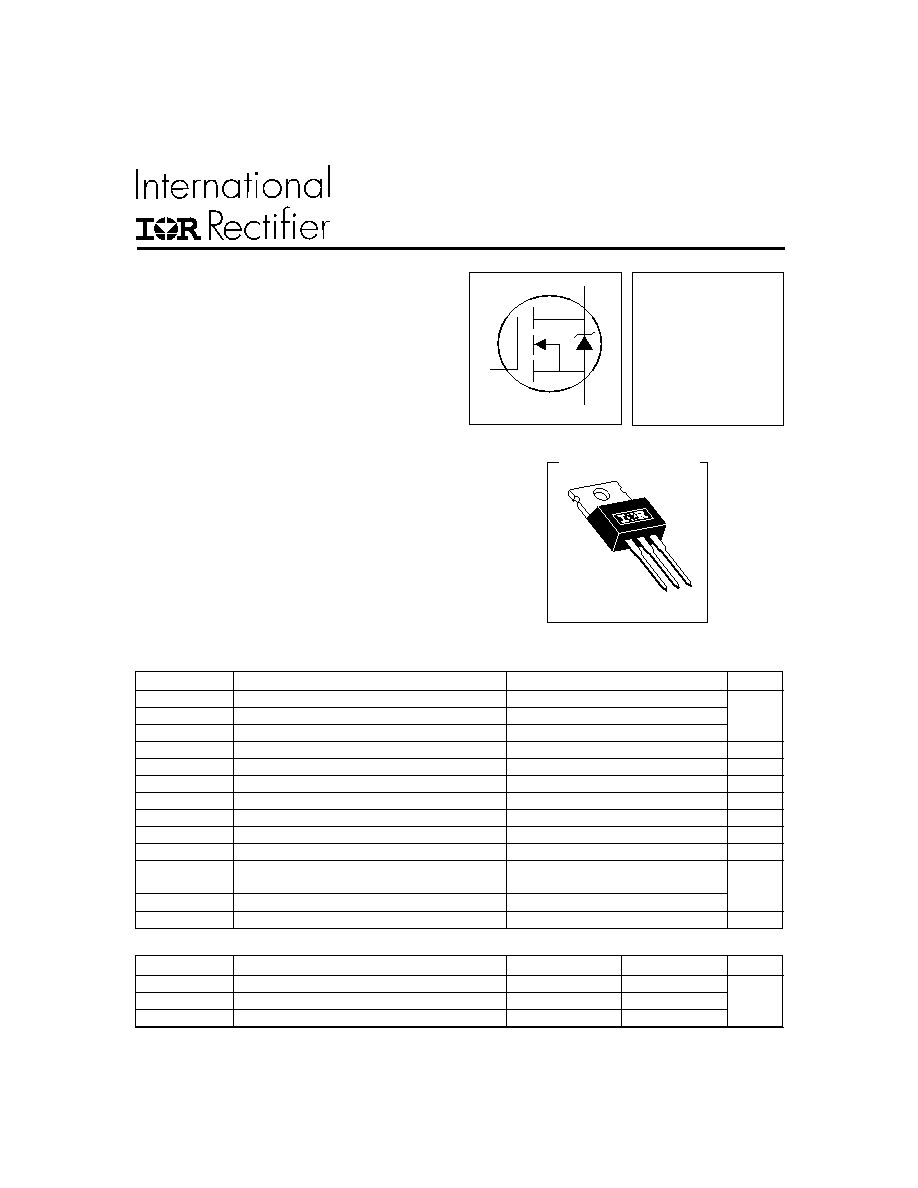
IRL530N
HEXFET
®
Power MOSFET
PD - 91348
C
S
D
G
V
DSS
= 100V
R
DS(on)
= 0.10
I
D
= 17A
TO-220AB
1/09/04
Parameter
Max.
Units
I
D
@ T
C
= 25°C
Continuous Drain Current, V
GS
@ 10V
17
I
D
@ T
C
= 100°C
Continuous Drain Current, V
GS
@ 10V
12
A
I
DM
Pulsed Drain Current
60
P
D
@T
C
= 25°C
Power Dissipation
79
W
Linear Derating Factor
0.53
W/°C
V
GS
Gate-to-Source Voltage
± 16
V
E
AS
Single Pulse Avalanche Energy
150
mJ
I
AR
Avalanche Current
9.0
A
E
AR
Repetitive Avalanche Energy
7.9
mJ
dv/dt
Peak Diode Recovery dv/dt
5.0
V/ns
T
J
Operating Junction and
-55 to + 175
T
STG
Storage Temperature Range
Soldering Temperature, for 10 seconds
300 (1.6mm from case )
°C
Mounting torque, 6-32 or M3 srew
10 lbf·in (1.1N·m)
Absolute Maximum Ratings
Parameter
Typ.
Max.
Units
R
JC
Junction-to-Case
1.9
R
CS
Case-to-Sink, Flat, Greased Surface
0.50
°C/W
R
JA
Junction-to-Ambient
62
Thermal Resistance
Description
Fifth Generation HEXFETs from International Rectifier
utilize advanced processing techniques to achieve
extremely low on-resistance per silicon area. This
benefit, combined with the fast switching speed and
ruggedized device design that HEXFET Power
MOSFETs are well known for, provides the designer
with an extremely efficient and reliable device for use
in a wide variety of applications.
The TO-220 package is universally preferred for all
commercial-industrial applications at power dissipation
levels to approximately 50 watts. The low thermal
resistance and low package cost of the TO-220
contribute to its wide acceptance throughout the
industry.
l
Logic-Level Gate Drive
l
Advanced Process Technology
l
Dynamic dv/dt Rating
l
175°C Operating Temperature
l
Fast Switching
l
Fully Avalanche Rated
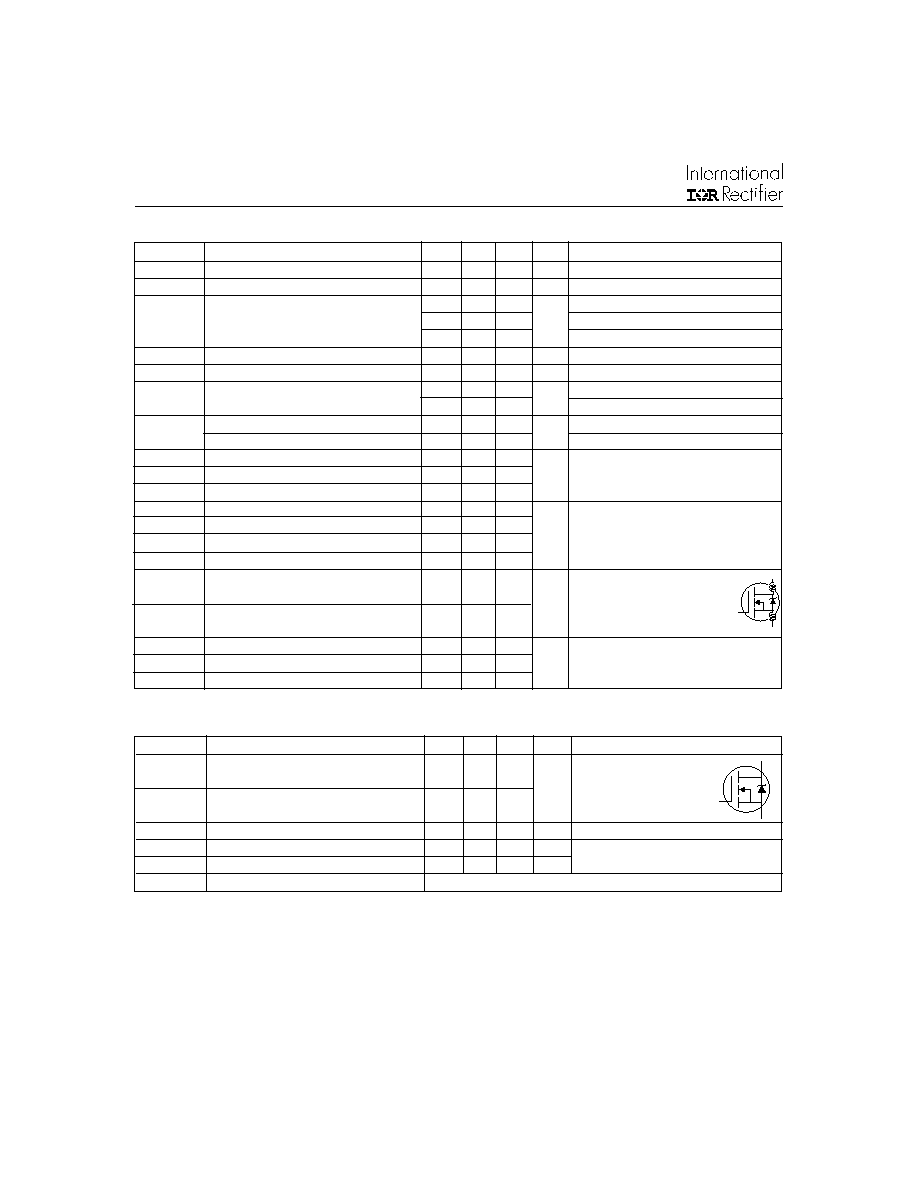
IRL530N
Parameter
Min. Typ. Max. Units
Conditions
V
(BR)DSS
Drain-to-Source Breakdown Voltage
100
V
V
GS
= 0V, I
D
= 250µA
V
(BR)DSS
/
T
J
Breakdown Voltage Temp. Coefficient
0.122
V/°C
Reference to 25°C, I
D
= 1mA
0.100
V
GS
= 10V, I
D
= 9.0A
0.120
V
GS
= 5.0V, I
D
= 9.0A
0.150
V
GS
= 4.0V, I
D
= 8.0A
V
GS(th)
Gate Threshold Voltage
1.0
2.0
V
V
DS
= V
GS
, I
D
= 250µA
g
fs
Forward Transconductance
7.7
S
V
DS
= 25V, I
D
= 9.0A
25
µA
V
DS
= 100V, V
GS
= 0V
250
V
DS
= 80V, V
GS
= 0V, T
J
= 150°C
Gate-to-Source Forward Leakage
100
nA
V
GS
= 16V
Gate-to-Source Reverse Leakage
-100
V
GS
= -16V
Q
g
Total Gate Charge
34
I
D
= 9.0A
Q
gs
Gate-to-Source Charge
4.8
nC
V
DS
= 80V
Q
gd
Gate-to-Drain ("Miller") Charge
20
V
GS
= 5.0V, See Fig. 6 and 13
t
d(on)
Turn-On Delay Time
7.2
V
DD
= 50V
t
r
Rise Time
53
ns
I
D
= 9.0A
t
d(off)
Turn-Off Delay Time
30
R
G
= 6.0
,
V
GS
= 5.0V
t
f
Fall Time
26
R
D
= 5.5
,
See Fig. 10
Between lead,
6mm (0.25in.)
from package
and center of die contact
C
iss
Input Capacitance
800
V
GS
= 0V
C
oss
Output Capacitance
160
pF
V
DS
= 25V
C
rss
Reverse Transfer Capacitance
90
= 1.0MHz, See Fig. 5
Repetitive rating; pulse width limited by
max. junction temperature. ( See fig. 11 )
Starting T
J
= 25°C, L = 3.
7mH
R
G
= 25
, I
AS
= 9.0A. (See Figure 12)
.
Notes:
Electrical Characteristics @ T
J
= 25°C (unless otherwise specified)
nH
I
GSS
S
D
G
L
S
Internal Source Inductance
7.5
R
DS(on)
Static Drain-to-Source On-Resistance
L
D
Internal Drain Inductance
4.5
I
DSS
Drain-to-Source Leakage Current
I
SD
9.0A, di/dt
540A/µs, V
DD
V
(BR)DSS
,
T
J
175°C
Pulse width
300µs; duty cycle
2%
S
D
G
Parameter
Min. Typ. Max. Units
Conditions
I
S
Continuous Source Current
MOSFET symbol
(Body Diode)
showing the
I
SM
Pulsed Source Current
integral reverse
(Body Diode)
p-n junction diode.
V
SD
Diode Forward Voltage
1.3
V
T
J
= 25°C, I
S
= 9.0A, V
GS
= 0V
t
rr
Reverse Recovery Time
140
210
ns
T
J
= 25°C, I
F
= 9.0A
Q
rr
Reverse RecoveryCharge
740 1100
nC
di/dt = 100A/µs
t
on
Forward Turn-On Time
Intrinsic turn-on time is negligible (turn-on is dominated by L
S
+L
D
)
Source-Drain Ratings and Characteristics
A
17
60
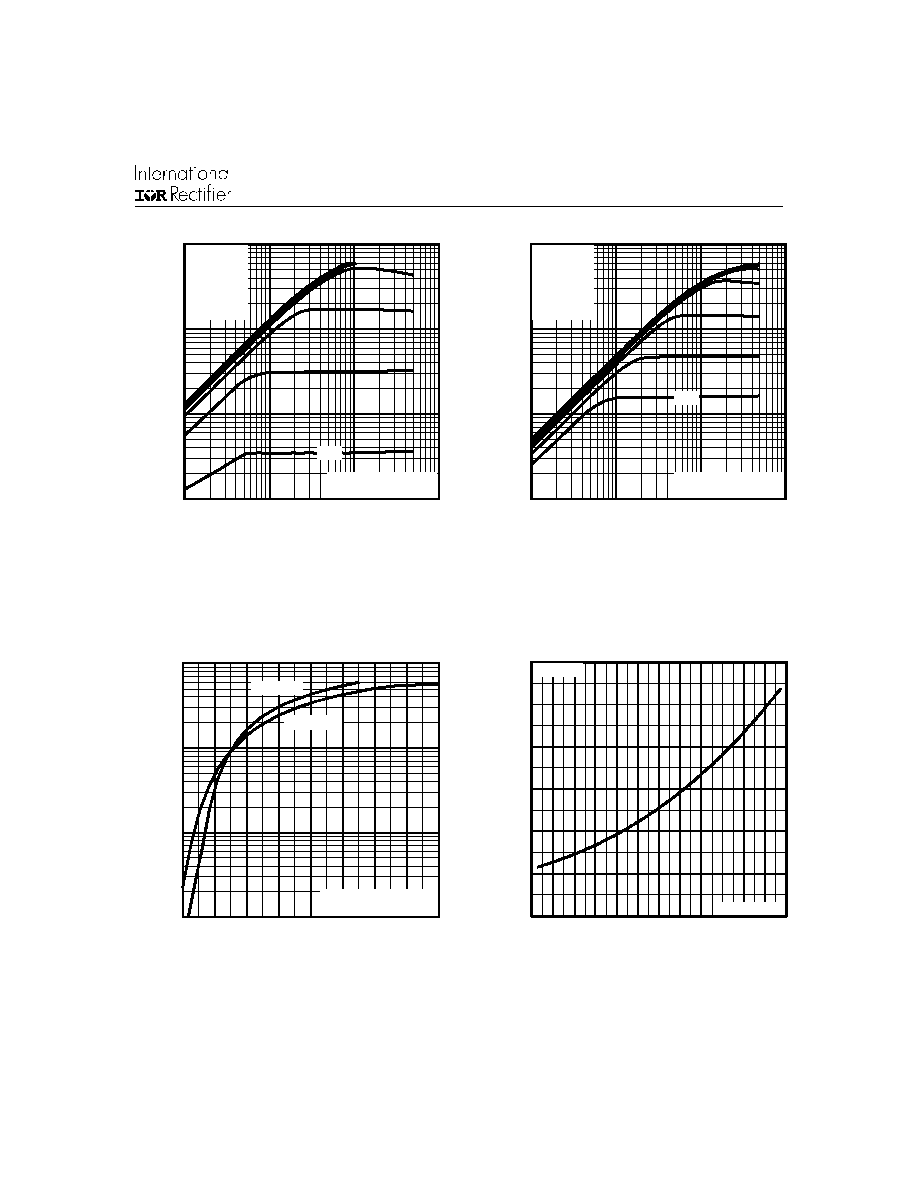
IRL
530N
Fig 1. Typical Output Characteristics
Fig 3. Typical Transfer Characteristics
Fig 4. Normalized On-Resistance
Vs. Temperature
Fig 2. Typical Output Characteristics
0.1
1
1 0
1 0 0
0.1
1
1 0
1 0 0
I
,
Dr
ai
n
-
t
o
-
S
ou
r
c
e Cur
r
e
n
t
(
A
)
D
V , D rain-to-S ource V oltage (V )
D S
A
2 0µ s P U LS E W ID T H
T = 2 5°C
J
VGS
TOP 15V
12V
10V
8.0V
6.0V
4.0V
3.0V
BOTTOM 2.5V
2 .5V
0.1
1
1 0
1 0 0
0.1
1
1 0
1 0 0
I
,
Dr
ai
n
-
t
o
-
S
ou
r
c
e Cur
r
e
n
t
(
A
)
D
V , D rain-to-S ource V oltage (V )
D S
A
2 0µ s P U LS E W ID T H
T = 1 75 °C
VGS
TOP 15V
12V
10V
8.0V
6.0V
4.0V
3.0V
BOTTOM 2.5V
2.5 V
J
0 . 1
1
1 0
1 0 0
2
3
4
5
6
7
8
9
1 0
T = 2 5 °C
J
G S
V , G ate-to -S o urce V oltag e (V )
D
I
,
D
r
a
i
n
-
to
-
S
o
u
r
c
e
C
u
r
r
e
n
t
(
A
)
V = 5 0V
2 0µ s P U L S E W ID TH
T = 1 7 5°C
J
A
DS
0 . 0
0 . 5
1 . 0
1 . 5
2 . 0
2 . 5
3 . 0
- 6 0
- 4 0
- 2 0
0
2 0
4 0
6 0
8 0
1 0 0 1 2 0 1 4 0 1 6 0 1 8 0
J
T , J unc tion T em perature (°C )
R
, D
r
a
i
n
-
to
-
S
o
u
r
c
e
O
n
R
e
s
i
s
t
a
n
c
e
D
S
(
on)
(N
o
r
m
a
li
z
e
d
)
V = 1 0V
G S
A
I = 15 A
D
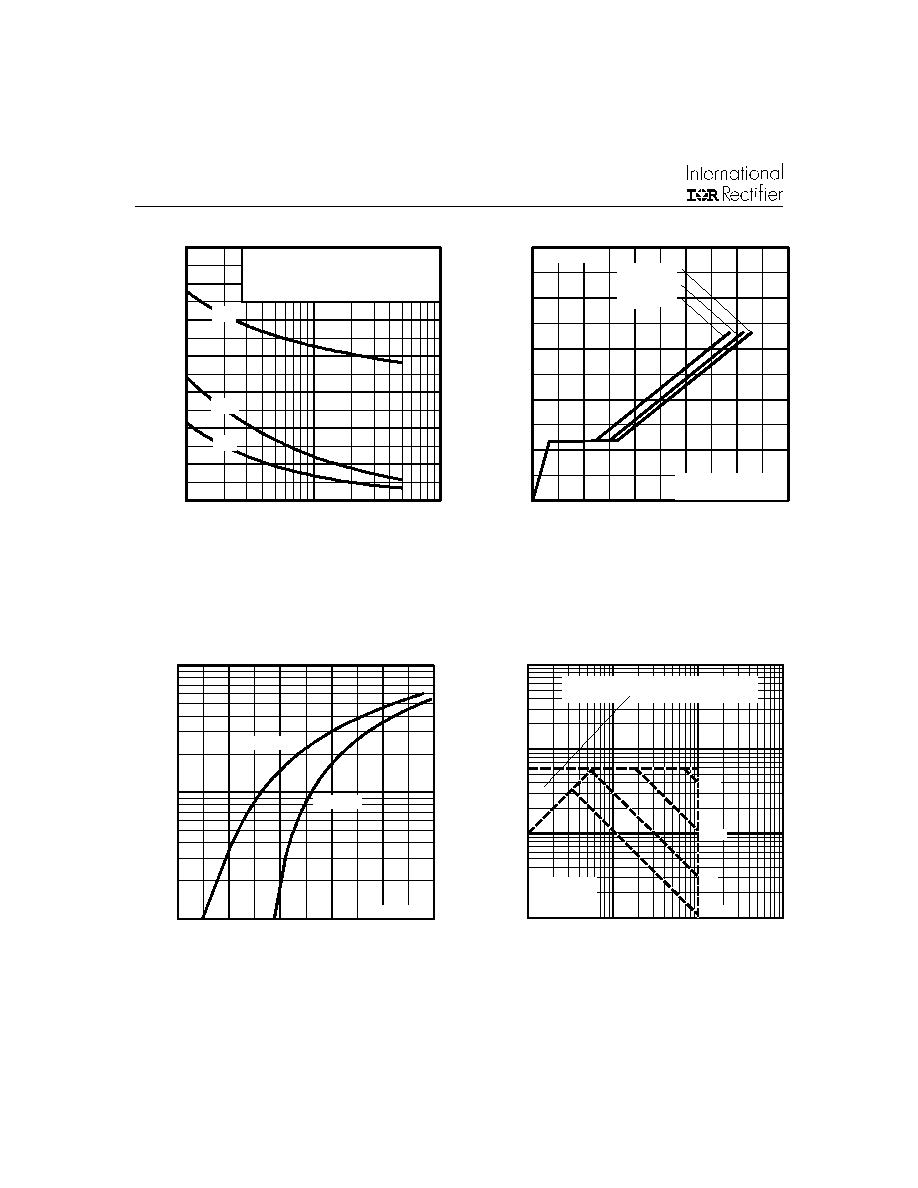
IRL530N
Fig 7. Typical Source-Drain Diode
Forward Voltage
Fig 5. Typical Capacitance Vs.
Drain-to-Source Voltage
Fig 8. Maximum Safe Operating Area
Fig 6. Typical Gate Charge Vs.
Gate-to-Source Voltage
0
3
6
9
1 2
1 5
0
1 0
2 0
3 0
4 0
5 0
Q , T otal G ate C harge (nC )
G
V
, G
a
te
-
t
o
-
S
o
u
r
c
e
V
o
l
t
a
g
e
(
V
)
GS
V = 8 0V
V = 5 0V
V = 2 0V
D S
D S
D S
A
F O R TE S T C IR C U IT
S E E F IG U R E 1 3
I = 9.0 A
D
1
1 0
1 0 0
0 . 4
0 . 6
0 . 8
1 . 0
1 . 2
1 . 4
T = 2 5°C
J
V = 0V
G S
V , S o urc e-to -D ra in V o lta ge (V )
I , R
e
v
e
r
s
e
D
r
a
i
n
C
u
r
r
e
n
t
(
A
)
S D
SD
A
T = 17 5°C
J
1
1 0
1 0 0
1 0 0 0
1
1 0
1 0 0
1 0 0 0
V , D rain-to-S ource V oltage (V )
D S
I
,
Dr
ai
n
C
u
r
r
e
nt
(
A
)
O P E R A T IO N IN T H IS A R E A LIM IT E D
B Y R
D
D S (o n )
1 0 µ s
1 0 0 µ s
1 m s
1 0 m s
A
T = 25 °C
T = 17 5°C
S ing le P u ls e
C
J
0
2 0 0
4 0 0
6 0 0
8 0 0
1 0 0 0
1 2 0 0
1 4 0 0
1
1 0
1 0 0
C
,
Cap
ac
i
t
a
n
c
e
(
p
F
)
D S
V , D rain-to-S ourc e V oltage (V )
A
V = 0V , f = 1 M H z
C = C + C , C S H O R TE D
C = C
C = C + C
G S
iss g s g d d s
rs s g d
o ss ds g d
C
is s
C
os s
C
rs s
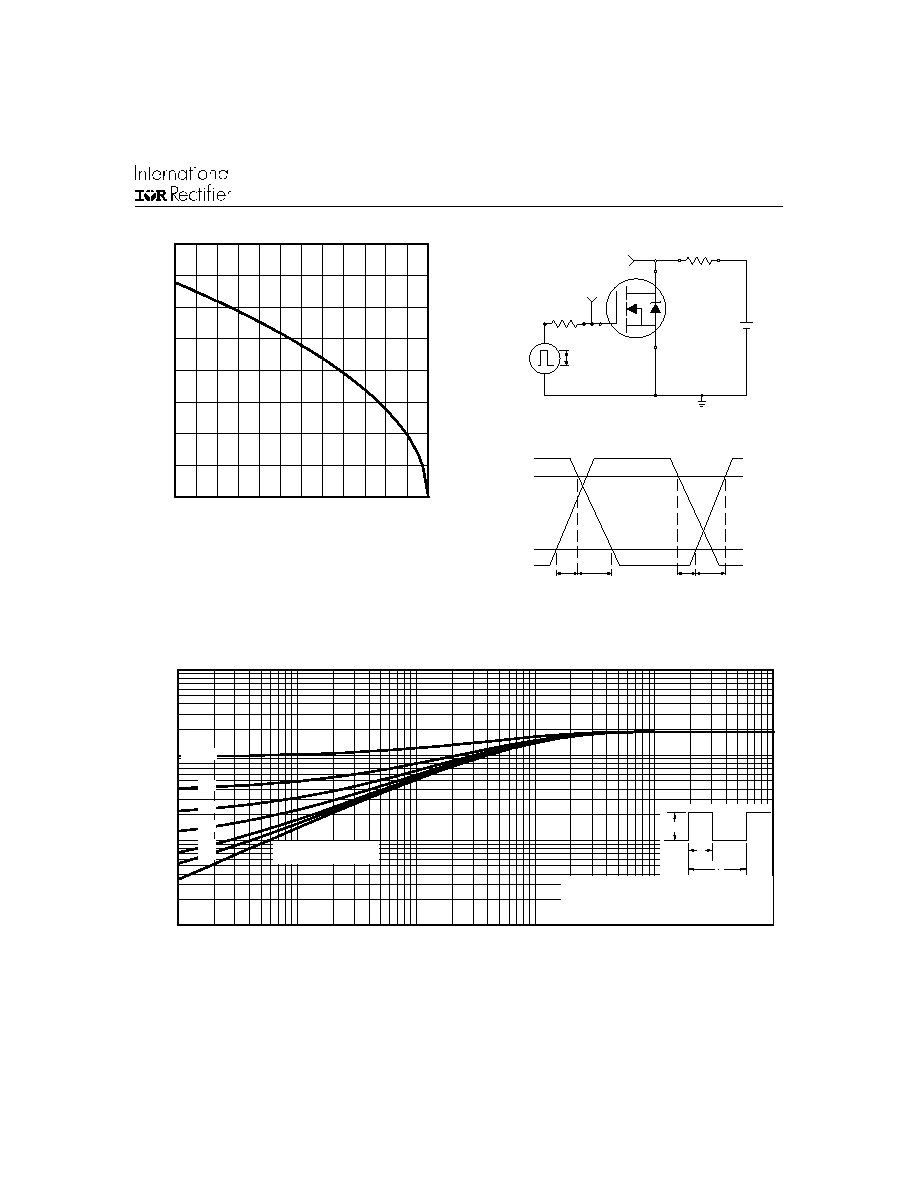
IRL
530N
0.01
0.1
1
10
0.00001
0.0001
0.001
0.01
0.1
1
Notes:
1. Duty factor D =
t / t
2. Peak T = P
x Z
+ T
1
2
J
DM
thJC
C
P
t
t
DM
1
2
t , Rectangular Pulse Duration (sec)
Thermal Response
(Z )
1
thJC
0.01
0.02
0.05
0.10
0.20
D = 0.50
SINGLE PULSE
(THERMAL RESPONSE)
Fig 9. Maximum Drain Current Vs.
Case Temperature
Fig 10a. Switching Time Test Circuit
V
DS
90%
10%
V
GS
t
d(on)
t
r
t
d(off)
t
f
Fig 10b. Switching Time Waveforms
Fig 11. Maximum Effective Transient Thermal Impedance, Junction-to-Case
V
DS
Pulse Width
1
µs
Duty Factor
0.1 %
R
D
V
GS
R
G
D.U.T.
5.0V
+
-
V
DD
25
50
75
100
125
150
175
0
5
10
15
20
T , Case Temperature ( C)
I , Drain Current (A)
°
C
D




